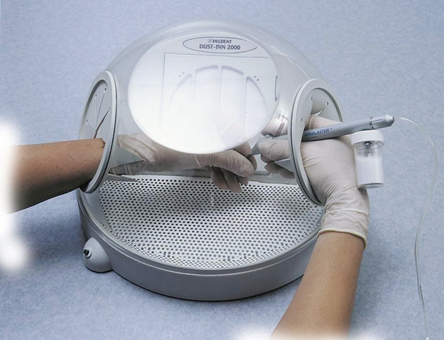



Indispensible in the Orthodontic Office
Airpolishing units are used routinely in general dental practice for plaque and stain removal and for every situation when enamel is cleaned, such as prior to bonding procedures. For example, Scott and Greer ( J.P.Dent 1987 ) found airpolishing to be the most effective, prior to fissure sealant application.
Following a paper by Gerbo, Barnes and Leinfelder (AJODO 1993 } the use of airpolishing is routinely taught in dental hygiene programs as a method of choice for cleansing the tooth surface.
Airpolishing is the method of choice for cleaning the enamel prior to bracket placement..
It has been shown to cause less damage to the enamel surface than the pumice and rubber cup technique ( Willmann et al JADA 1980) In addition, Sodium Bicarbonate is soluble and
easily and completely washed away, Pumice is not- micron particles can be retained in the enamel grooves, and interfere with the bonding.
Rapid and simple plaque and debris removal allows the orthodontist to work in a clean esthetic field. The remnants of recent meals or in-between snacks need no longer waste valuable chairside time. No need to set up a hygiene appointment, a few moments with the Jetpolisher 2000 is all that it takes to clean the field.
Barnes et al. found that airpolishing was the most effective method of plaque removal for orthodontic patients, providing excellent access without damage to the orthodontic appliance. Frequent cleaning with an airpolisher resulted in a greater reduction in gingival bleeding and marginal redness compared with the pumice and rubber cup technique. This was attributed to the more thorough removal of plaque. It is virtually impossible to adequately clean around fixed appliances using a rubber cup technique. The Jetpolisher 2000 is an invaluable aid in the prevention of enamel decalcification around orthodontic appliances
The Jetpolisher 2000 makes light work of clean up following debanding procedures. A few minutes with the Jetpolisher 2000 will remove all the residual stain. At follow-up appointments after debanding, some additional staining is sometimes seen, the Jetpolisher 2000 is close at hand to deal with this.
The Jetpolisher 2000 incorporates the unique HST ™ Homogeneous Stream Technology Polishing system. In this system:
The Deldent Miniblaster™ is being recognized as an indispensable chairside tool in the orthodontic practice. Among its applications are the following:
Not uncommonly, an orthodontic bracket may be dislodged from the tooth during orthodontic treatment. If this occurs, the choice is either to replace it with a new bracket (additional cost of bracket) or if available, to recycle the bracket by means of a recycling technique.
Sandblasting of the mesh of the bracket will completely remove old existing composite and will enable the same bracket with a superior sandblasted surface to be rebonded in the same patients mouth immediately. The total procedure takes only a few moments and a few cases will quickly cover the cost of the unit, in time and convenience, as well as a saving in cost of additional brackets.
Molar bands may come loose during treatment . In most cases, it is the bond between the adhesive cement and the band that has failed, the adhesive to tooth junction often remaining intact. Prior sandblasting of the inner surface of the bands, especially in critical situations, such as with a rapid palatal expansion appliance, can significantly reduce this occurrence.
Bands that come loose should be sandblasted. This will remove old cement and prepare the band surface for re-cementation.
Simple retainers (e.g. lingual cuspid to cuspid retainers) can be fabricated and bonded to the teeth, after sandblasting the bonding areas of the adapted wire (Zachrisson JCO 1995)
Bonding can be more difficult in the adult patient where a great variety of restorations may be encountered, that cannot be bonded to, with routine bonding protocols, as is the case when bonding to the natural teeth. These include crown and bridgework and restorations of various materials; amalgam, composite, porcelain and precious metals.
Effective bonding to artificial surfaces has been facilitated by new techniques and materials but mechanical retention is an important ally to all bonding techniques
Roughening a surface with burs or stones may create the appearance of roughness due to the periodic grooves and ridges but little micro-mechanical retention is achieved.( Edel A.and Edel J. Ind Dent. 1998)
The Deldent Miniblaster strips away contaminants and a microscopic layer of metal, composite or porcelain depending on the material being blasted, creating a retentive surface with a miryad of microscopic undercuts. This increased surface roughness significantly enhances bond strength.
The Deldent Miniblaster has been approved by the FDA for intra-oral use to enhance bonding and its additional clinical applications are only limited by the imagination of the operator.
The DUST INN 2000™ Compact Esthetic Dust Collector is an excellent companion to the Miniblaster. It is designed for use with all Miniblasters or Microetchers and for chairside grinding procedures.
It has excellent all round visibility and features an efficient 12 volt filtered extraction system that is quiet, and by creating a negative pressure that efficiently contains the abrasive particles in the unit and not in the operatory.
No need to trip down the hall to the lab. Now, everything is conveniently available just a half turn away, thanks to this esthetic and practical device which is nice enough to let your patients see. This is especially beneficial when treating anxious youngsters, and allows you to maintain the uninterrupted patient/doctor exchange that is so important.
The Dust-Inn is a high-style contemporary unit that not only fits well into the clean, sleek design of modern dental décor, but eliminates the need for accessory lighting, due to the transparent dome that provides all-round visibility. Best of all the Dust-Inn is scaled to fit on an operatory countertop without getting in the way.